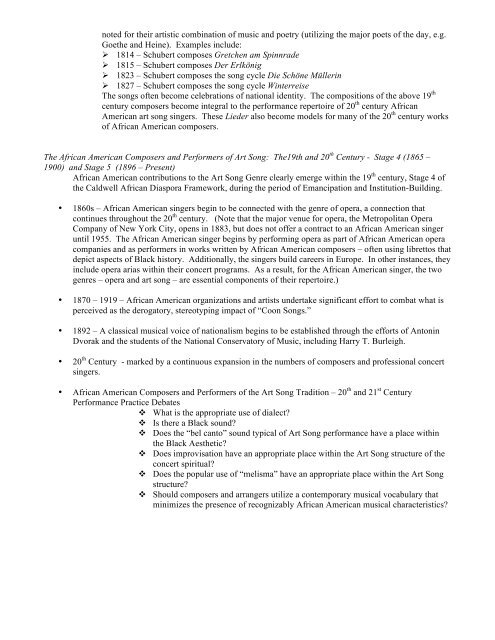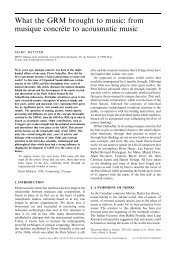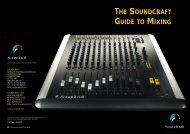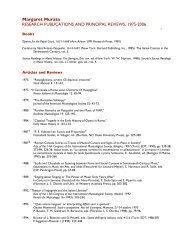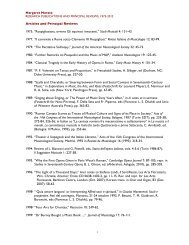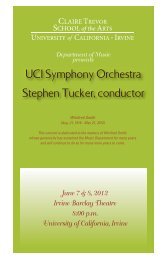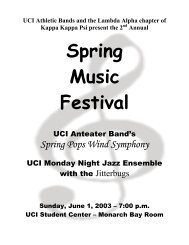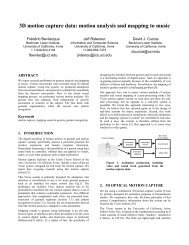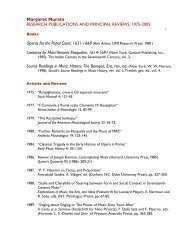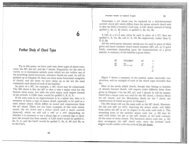âRoots and Branchesâ - Music - University of California, Irvine
âRoots and Branchesâ - Music - University of California, Irvine
âRoots and Branchesâ - Music - University of California, Irvine
You also want an ePaper? Increase the reach of your titles
YUMPU automatically turns print PDFs into web optimized ePapers that Google loves.
noted for their artistic combination <strong>of</strong> music <strong>and</strong> poetry (utilizing the major poets <strong>of</strong> the day, e.g.<br />
Goethe <strong>and</strong> Heine). Examples include:<br />
1814 – Schubert composes Gretchen am Spinnrade<br />
1815 – Schubert composes Der Erlkönig<br />
1823 – Schubert composes the song cycle Die Schöne Müllerin<br />
1827 – Schubert composes the song cycle Winterreise<br />
The songs <strong>of</strong>ten become celebrations <strong>of</strong> national identity. The compositions <strong>of</strong> the above 19 th<br />
century composers become integral to the performance repertoire <strong>of</strong> 20 th century African<br />
American art song singers. These Lieder also become models for many <strong>of</strong> the 20 th century works<br />
<strong>of</strong> African American composers.<br />
The African American Composers <strong>and</strong> Performers <strong>of</strong> Art Song: The19th <strong>and</strong> 20 th Century - Stage 4 (1865 –<br />
1900) <strong>and</strong> Stage 5 (1896 – Present)<br />
African American contributions to the Art Song Genre clearly emerge within the 19 th century, Stage 4 <strong>of</strong><br />
the Caldwell African Diaspora Framework, during the period <strong>of</strong> Emancipation <strong>and</strong> Institution-Building.<br />
• 1860s – African American singers begin to be connected with the genre <strong>of</strong> opera, a connection that<br />
continues throughout the 20 th century. (Note that the major venue for opera, the Metropolitan Opera<br />
Company <strong>of</strong> New York City, opens in 1883, but does not <strong>of</strong>fer a contract to an African American singer<br />
until 1955. The African American singer begins by performing opera as part <strong>of</strong> African American opera<br />
companies <strong>and</strong> as performers in works written by African American composers – <strong>of</strong>ten using librettos that<br />
depict aspects <strong>of</strong> Black history. Additionally, the singers build careers in Europe. In other instances, they<br />
include opera arias within their concert programs. As a result, for the African American singer, the two<br />
genres – opera <strong>and</strong> art song – are essential components <strong>of</strong> their repertoire.)<br />
• 1870 – 1919 – African American organizations <strong>and</strong> artists undertake significant effort to combat what is<br />
perceived as the derogatory, stereotyping impact <strong>of</strong> “Coon Songs.”<br />
• 1892 – A classical musical voice <strong>of</strong> nationalism begins to be established through the efforts <strong>of</strong> Antonin<br />
Dvorak <strong>and</strong> the students <strong>of</strong> the National Conservatory <strong>of</strong> <strong>Music</strong>, including Harry T. Burleigh.<br />
• 20 th Century - marked by a continuous expansion in the numbers <strong>of</strong> composers <strong>and</strong> pr<strong>of</strong>essional concert<br />
singers.<br />
• African American Composers <strong>and</strong> Performers <strong>of</strong> the Art Song Tradition – 20 th <strong>and</strong> 21 st Century<br />
Performance Practice Debates<br />
What is the appropriate use <strong>of</strong> dialect?<br />
Is there a Black sound?<br />
Does the “bel canto” sound typical <strong>of</strong> Art Song performance have a place within<br />
the Black Aesthetic?<br />
Does improvisation have an appropriate place within the Art Song structure <strong>of</strong> the<br />
concert spiritual?<br />
Does the popular use <strong>of</strong> “melisma” have an appropriate place within the Art Song<br />
structure?<br />
Should composers <strong>and</strong> arrangers utilize a contemporary musical vocabulary that<br />
minimizes the presence <strong>of</strong> recognizably African American musical characteristics?


